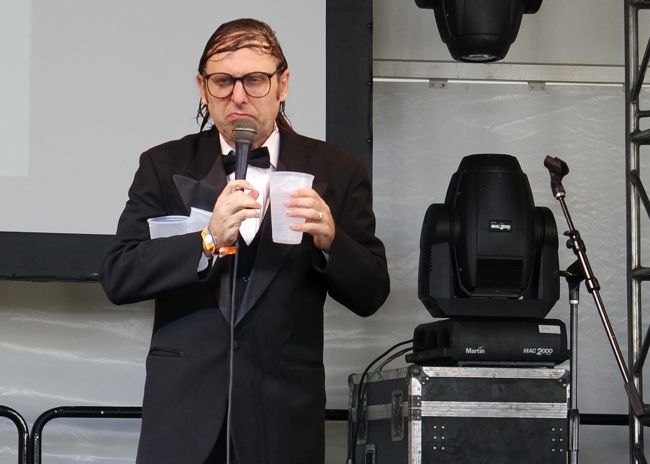
Neil Hamburger
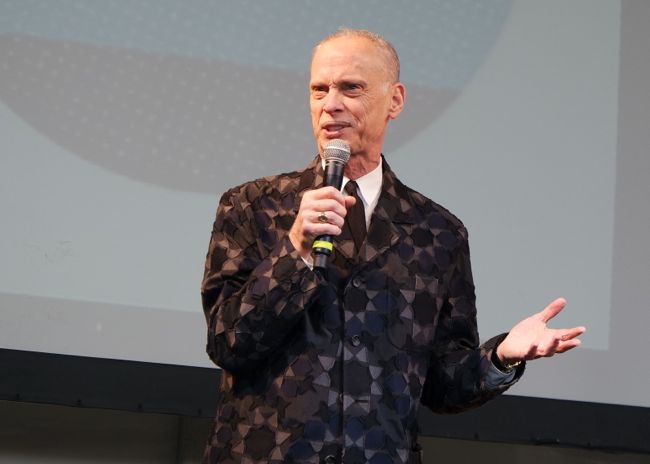
John Waters

Alt-J

Judas Priest


John Waters

Alt-J

Judas Priest
So, it’s no longer October, but I still have all these horror movies that I’m excited to watch. So I guess I’ll keep doing this whole “horror movie review” thing, maybe review some non-horror movies too, while I still have the urge.
Last night I watched Jennifer Kent’s The Babadook.
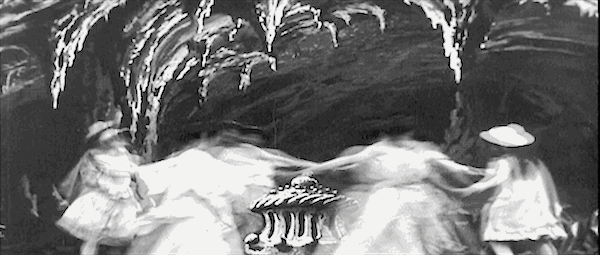
It was incredible.
Here’s the official synopsis, from their website:
From breakthrough writer-director Jennifer Kent comes the creepy psychological horror movie THE BABADOOK… in the tradition of Polanski’s classic domestic horrors… a single mother, plagued by the violent death of her husband, who battles with her son’s night time fear of a shadowy monster. But soon, she discovers a sinister presence is lurking in the house.
And sure, it’s all of those things. But it’s a hell of a lot more than that– it’s the best metaphor for deep, dark clinical depression that I’ve ever seen on the silver screen.

I know that’s kind of a whopper of a statement. There are wonderful representations of clinical depression in all media. Kate Gompert in Infinite Jest, or DFW’s other powerful statements on it (including Good Old Neon and The Depressed Person). There are also, of course, wonderful movies dealing with clinical depression head-on: Ordinary People, The Hours, Melancholia. But I’ve always been partial to symbolism and metaphor, and this movie fucking nails it.
Essie Davis, who I absolutely adore as the title character in Miss Fisher’s Murder Mysteries, plays the main role in this movie, Amelia. Her son, Samuel, is played by a child actor that I’d never heard of before, and who does an incredible job portraying a rowdy, rambunctious, handful of a child.
The basic setup is simple. Amelia’s husband Oskar died in a car crash while driving her to the hospital to give birth to Samuel. She does her best as a single mother, working as a nurse. Samuel has more than his fair share of behavioral problems, which raise horrible issues with his school, as well as among his classmates, social peers, and other family members.
Samuel finds a book in the house called “MISTER BABADOOK,” featuring a terrifying top-hatted closet monster who terrorizes a young boy in his bed. By the time Amelia realizes this book is deeply disturbing and wildly inappropriate for a young child, it’s too late. The damage has been done, and Samuel is terrified of the Babadook. Amelia hides the book.
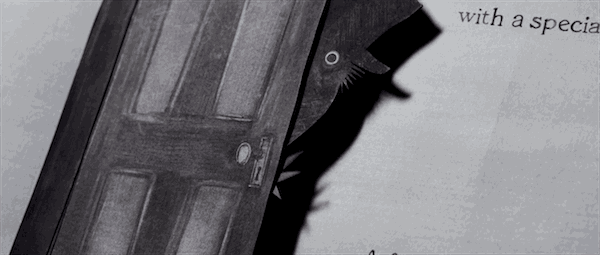
(The book design and implementation, by the way, is beautiful. Clearly handmade, hand-illustrated, and hand-lettered, it is a marvel of art and design. I had to fight back the impulse to include way too many gifs while writing this blog. Each new two-page spread is a wonder of pop-up and moveable parts. As a bibliophile, I was delighted by it– and I signed up on their website to be alerted if and when they make the book itself available for sale.)
When his behavior gets him in trouble at school (again), the head of academics sits Amelia down and says that they’ve decided to separate Samuel from his classmates and assign him a monitor to be at his side all the time. Amelia, already frustrated at Samuel’s alienation from his peers, decides to take him out of school and look for a new school.
Then everything slowly begins to unravel.
Samuel finds the book and is terrified anew. Amelia tears it up and throws it in the garbage.
Now, Samuel’s birthday is approaching, which is also the date of Oskar’s death. Amelia is dealing with overload from constant contact with her behaviorally problematic child, the sheer horror and depression of the fact that his birthday shares the same day as her life’s greatest tragedy, the financial pressure and stress from being unable to work because she needs to care for her child, Samuel’s overarching fear of the Babadook, and the oppressive loneliness she feels at being unable to really talk to anyone else.
Samuel doesn’t sleep. She doesn’t sleep.
It’s enough to take its toll on anyone.

She goes to see her doctor, who refers her to a psychiatrist. She begs him for sedatives to help Samuel sleep. He provides some for her, and they get their first good night’s sleep. The next morning the Babadook book reappears on their doorstep, carefully put back together, and it has new pages. New horrible, awful, distressing pages.
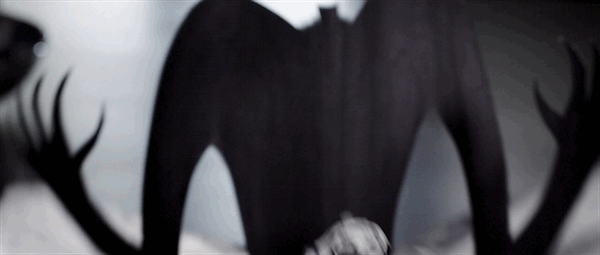
And then things get just much, much worse.

I really, really hate spoilers. I tend to avoid them at all costs, because I know that I can’t stop myself from reading them if I come upon them at the tail end of an article that I’m enjoying. This copy of The Babadook is a review copy, and so I especially don’t want to spoil it when it’s unavailable for most people that will read this blog. That said, I’ve seen a fair amount of reviewers (and internet folks) say that they dislike the ending, or that they don’t understand the ending.
I’ll just say that, as someone who has struggled with clinical depression, and who fully expects to struggle with it for the rest of my life, I liked the ending. The ending made sense to me.
Now, when you get the chance, see this movie. Throw money at this movie. Make sure that these people get to make more movies.

Okay, here’s the final entry in this year’s 31 Days of Horror.
It’s for the second movie I watched this month, so it seems kind of silly to be doing it on Halloween, but it truly deserves a post all its own. It’s a weird French masterpiece, and I can’t sing its praises highly enough.
I’d heard of this movie before, of course, and I’d heard the Billy Idol song. I’d seen the poster and even some screenshots of the creepy main character with her creepy, creepy mask. But I’d never watched it, although I’d heard how good it was. So I was taken by surprise by its elegance, pacing and atmosphere.
The plot starts with a woman, played by Alida Valli– featured in my favorite movie of all time, The Third Man, and another that’s in my top ten of all time, Suspiria— driving down a road late at night, dragging the body of a young girl out of the back of her car, and throwing the corpse into the Seine. Then we are introduced to a doctor giving a lecture about grafting living tissue from one subject to another. After the lecture, he is summoned to the police station, where the police believe they have fished the body of his daughter from the river. The corpse has similar facial injuries, you see– where the face should be, there is just an open wound. The good doctor gives confirmation that it is his daughter, Christiane.
At the funeral, he is accompanied by Alida Valli.
Back at his villa, we meet his daughter, who is heartbroken about her lack of face, and who has found her own funeral announcement. The good doctor explains that because the other girl died during the face transplant, he just identified the body as his daughter so no one would think she was alive. Since she isn’t wearing her mask– we only ever see the back of her head during this sequence– he reminds her that she needs to get into the habit of wearing the mask until he can fix her face. She mentions that they’ve removed all the mirrors, but she can still see her face in the window glass, or varnished wood, or a knife blade.
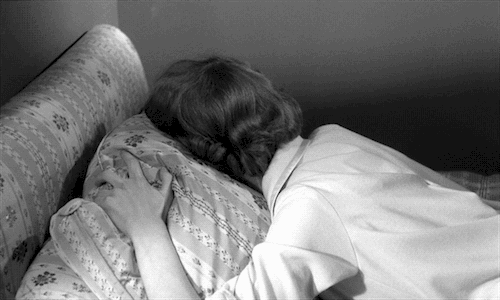
All of which brings us to minute 24 of a 90-minute movie. This film takes its time, man.
That said, at this point it all ratchets up a notch. The plot remains simple. Doctor consumed with guilt for causing his daughter’s disfigurement takes extreme measures (including kidnapping and murder) in an attempt to fix her face. Daughter, deeply depressed and teetering on the brink, deals with the reality of her mad-doctor father’s misdeeds, and attempts to balance them against her hypothetical happiness at having a functional face again. Where this movie really shines is in the beautiful pacing, performances, sets, and direction.
Edith Scob’s performance in this movie is incredible. She has to do a massive amount of emoting with just her body movements and her eyes, and she pulls it off beautifully.

That mask, by the way? John Carpenter said that it was a source of inspiration for Michael Myers’ featureless Shat-mask in Halloween.
At one point Christiane, having just witnessed her father and Alida Valli drug a girl and strap her to a hospital table, walks through the surgical room to a room full of caged animals, which her father undoubtedly (and thankfully off-camera) uses for his gruesome experiments in heterografting. The dogs don’t pity her, and they aren’t afraid of her because of the mask. They’re just thankful for the attention, and the care.

Walking back through the surgical room, she finds a mirror, removes her mask, and inspects herself. Then she walks over to the drugged girl on the table and sees her perfect face.
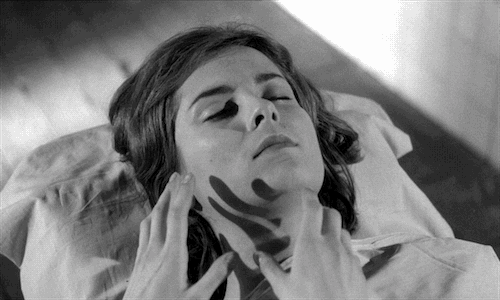
One of the fascinating aspects of this movie is that there isn’t really a villain– or at least, there isn’t really evil. The Doctor’s motivations are clear and sympathetic. He’s caused a horrible tragedy, and will go to great lengths to correct it, but he is not evil, just driven a little insane by the folly of his shortcomings. His assistant Louise, played by Valli, is so grateful to the doctor for fixing her face that she’s willing to follow him to the ends of the earth to accomplish what she sees as a great goal. Christiane herself is an innocent, a John Merrick-style character, pitiable, heartbreaking. She is implicit in her father’s misdeeds, certainly, by allowing him to declare her dead, and going along with his kidnapping-and-nonconsenting-surgery plots, but she’s just a teenage girl, faltering in an uncertain world.
Which brings us to the film’s end. After standing by as her father (before the movie begins) kidnapping and murdering a girl in an attempt to graft her face onto his daughter; kidnapping another girl, transplanting her face away, and then watching as she commits suicide; and finally, kidnapping a third girl, Christiane decides that she can no longer share complicity in what’s going on. When her father is called away by the police, who have been investigating, Christiane is left alone in the surgical room with the latest transplant donor. She takes decisive action. I don’t want to get too spoiler-y. But one of the things she does is release all of the caged animals her father experimented on.
Here is a huge gif. This thing is bigger than the rest of the gifs combined but I love this damn scene so much.

This movie is like Hitchcock meets Cocteau. I can’t tell you how much I like the eerie, slow, sad French horror.
I had a hell of a time picking gifs for this. If you’re curious there are a few more that I didn’t use, but you can watch by clicking these two words.
As a side note, if you know me fairly well, you also know that I’m a huge poster collector nerd. So after I watched it, I ran out and found the original 1960 French one-sheet. It arrived last week, and here it is, in all its glory.
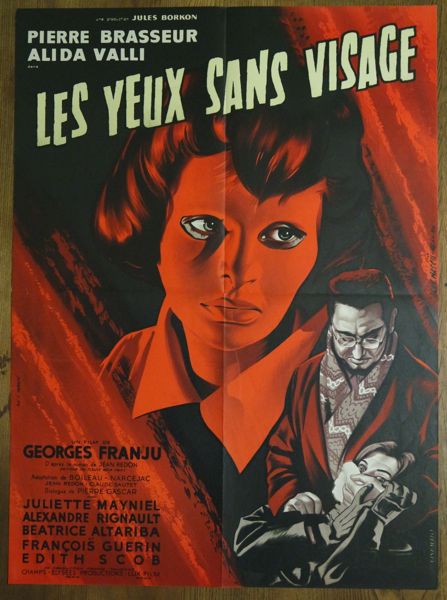
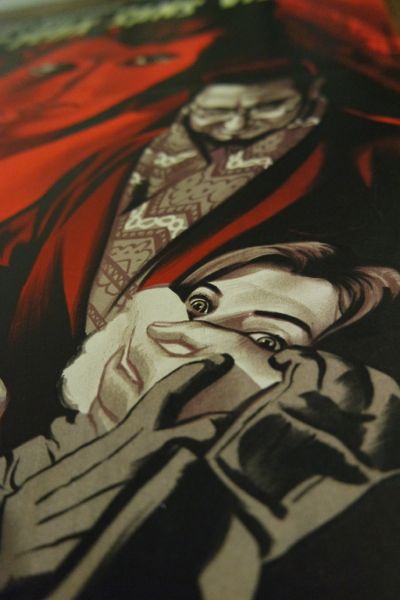
Wow. I did it. 31 horror movies in the month of October. And there’s still three days to go! I’M BREAKIN’ RECORDS OVER HERE
This is an interesting flick. I’d had it recommended to me before, but never really looked into it. It just seemed to me– from, granted, what was a cursory glance– to be your standard early-1980s slasher flick. The poster was just a bloody axe dangling from a dude’s hand, so there wasn’t a whole lot to recommend it.
This time, it hovered into my field of interest, and when it was recommended to me, the cast was played up– and whoa, what a cast. Jack Palance, Donald Pleasence, Martin Landau, plus a bevy of supporting character actors. Landau and Palance are crazy people in an asylum run (very loosely) by Donald Pleasence, and when one of the doctors retires and is replaced, the most dangerous inmates decide that the new doctor must have killed the old one. So they make it their mission to hunt him down and kill him.
And man, Jack Palance chews the scenery beautifully in this movie.

Although, to be fair, everyone chews the scenery beautifully in this movie.
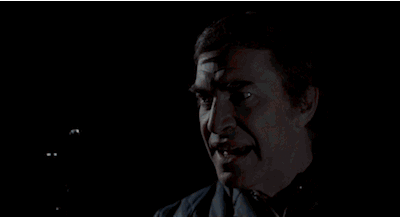
The movie is helped along by a great supporting cast– the new doctor (played by the same guy who was “Howlin’ Mad” Murdock in The A-Team) has a family, and they’re all written and played well, generating empathy and concern in a genuine way, rather than feeling totally manufactured. You can tell the writer and director liked these characters, rather than just cramming a bunch of people together and hoping we’d root for them out of some generic protagonist cameraderie.
Don’t get me wrong, though, there are plenty of rando murders. At one point, Jack Palance is driving the van full of lunatics down a suburban street, and they come upon a postman riding his bike. “I want his hat,” says Landau. Palance starts driving faster and faster to chase the guy down, and the postman makes the terrible mistake of calling Palance an asshole. So naturally, this requires retribution.
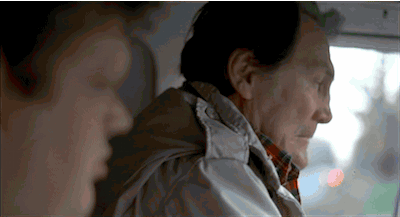
There are also a fair amount of tropes and standard horror-movie fare. There’s a bunch of violent nuts escapaed from an asylum, a conveniently-timed power outage, one of the psychos wears a hockey mask (although this came out the same year as Friday the 13th Part III, the first time Jason Voorhees wore a hockey mask– I’m not sure which came first), there’s your standard boobtastic “college kids fool around until they get murdered” scene, corpses falling out of a closet that our heroes are trying to hide in, a good cop who meets a bad end, a surprise twist, et cetera.
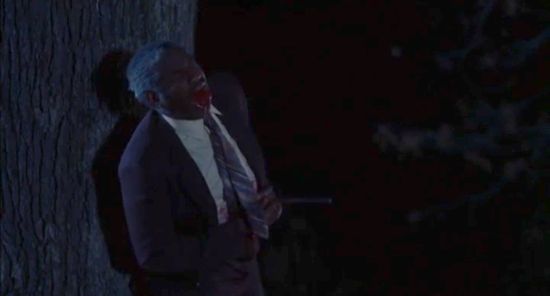
They’re all played pretty straight, but in context they seem– well– not exactly tongue-in-cheek, but definitely a little meta and self-aware, although not in a humorous or parodic way. They’re just nods to the genre, and they’re all done really well and serve to further the plot or allow for the continuation of the larger story.
But really, most of the character interactions are stellar, especially when it’s the principals. There’s a confrontation between Donald Pleasence’s well-intentioned but naive doctor and Martin Landau’s murderous ex-preacher that’s worth the price of admission just by itself.
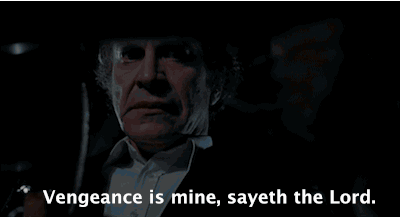
The pacing, writing, casting, and acting set this apart from most of the 80s slashers out there. I enjoyed it thoroughly.
I love movies like this.
This is steaming hot trash from the early 80s, done on a shoestring budget. It’s super-goofy and fun, and it looks like it was just as fun to make it as it is to watch. On top of that, the creature effects are actually really fantastic, and the character development is pretty well done.
The gore is sincerely insane. This is a movie that feels like a goofy teenager chiller-thriller, but then periodically something insanely messed up happens. The plot is fairly straightforward: a meteor crashes, some campers go to investigate, outer-space monsters murder them.
The outer-space monsters wander their way into a basement, where they begin to wreak havoc on the inhabitants of the house in amazingly graphic and shocking ways.

Oh yeah. This thing is going to have nothing but animated gifs. You can blame Ed Ringtone for this. Because I am a man who has learned a new technology, I have determined that I must use this new technology for everything. When you have a hammer, everything looks like a skull, right?
Anyway.
Did I mention that, in addition to all the horrendous gore, this movie has weird, gratuitous boobs?
Here’s the woman from the earlier gif, shown here after getting out of bed. She is still alive at this point.

That shot goes on for thirty seconds. She gets out of bed, stretches, looks at her hair in the mirror, adjusts it a little bit, turns, walks to the window, looks at the window, and is mildly disappointed that it is raining– which is the portion that I have chosen to show you here. Then she puts on her robe.
That is some straight-up dedication to gratuitous boobs covered in sheer material.
Anyway, she goes to look for her husband in the basement and gets murdered, as seen earlier.
Meanwhile, there are about eight other families in the house. This house is huge. One of the families has a little kid who’s super into movie monsters and wears a red Dracula cape around. A different family in the house has a psychiatrist father, and there is a long sequence where he tries to psychoanalyze the kid who loves monsters. He asks him if he believes that monsters are real, or that he would ever see a monster, and the kid responds that no, of course not, monsters aren’t real. Because duh.
Eventually, he shuts up, and the kid wanders down into the basement, and finds the horrible monster, all of its wee horrible spawn, and the corpses of the people who have already gone to the great watery basement in the sky. Here is that superb, glorious reaction shot.
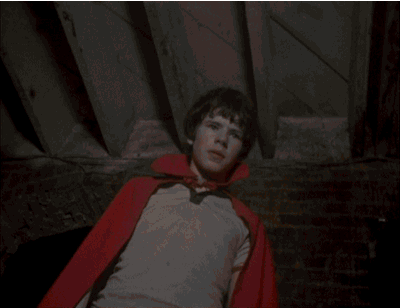
But what’s this? Some of the other, older kids have found one of the weird spawn-babies in the creek. They discuss its phylum and genus, along with a historical tangent about the re-discovery of the coelacanth, a weird ancient fish thought to be extinct until its rediscovery in 1938.
Rather than choosing to believe that it is a coelacanth, one of the fellows posits that it is a baby freshwater eel.
They disagree.
One of them decides to dissect it, and asks the one who lives there if his mother has a cookie sheet or something.
They do.
Then they cut back to the kid in the basement, watching the weird alien babies eat the head of his friend’s mother for an absurd amount of time:

So he’s been down there just watching ridiculous carnage take place. At this point he’s been down there for maybe an hour of movie timeline-time. Just, you know, chillin’ out with the corpses of people he knows, plus a huge monster and a whole passel of tiny monsters.
You know, like you or I would do.
Eventually he wanders back upstairs.
Thankfully, we’re spared a long sequence where the kid tries to convince people that there are monsters in the basement. We are spared this tired indignity of a trope because the monsters are killing everybody upstairs. A few of the college kids are left, for a little while, at least, until one of them is beheaded by the monster and thrown out a window, in a shot that is basically the entire reason that I love movies like this:
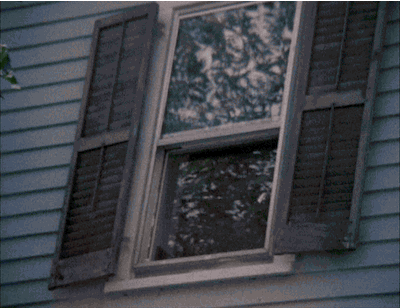
That sequence has three cuts and they exist for no real reason.
I wholeheartedly recommend this totally ridiculous gorefest of a movie.
I’m almost at 31. I didn’t think I’d actually do that.
I also published a blog post every day last week. I honestly think it’s been probably a decade since I did that. Sheesh.
I guess I love horror movies that goddamn much.
Let’s get into it.
This is the only movie that Saul Bass directed. If you don’t know Saul Bass, you should– he designed some of the greatest title sequences in the history of film, stuff like North By Northwest, Vertigo, Psycho, The Man With the Golden Arm, Bunny Lake Is Missing, Anatomy of a Murder, and many more. He was also a preeminent influence on design in the latter half of the twentieth century altogether, designing some of the most brilliant, simple, and memorable movie posters ever created. Stuff like Vertigo, Anatomy of a Murder, The Shining, It’s a Mad, Mad, Mad, Mad World, and more too numerous to list here.
The guy is a legend. And the opening sequence of this movie goes a long way towards illustrating that. It starts off with a beautiful minimalist scene of the earth circling a sun, along with a voiceover describing something going strangely with “magnetic fields” and radiation. Then there are another few minutes of close-up photography of ants, scurrying around, chatting with their googly antennae, et cetera, while the voiceover explains that they’ve been inexplicably changed by the magnetic field / radiation thing.
The whole thing is really pretty.
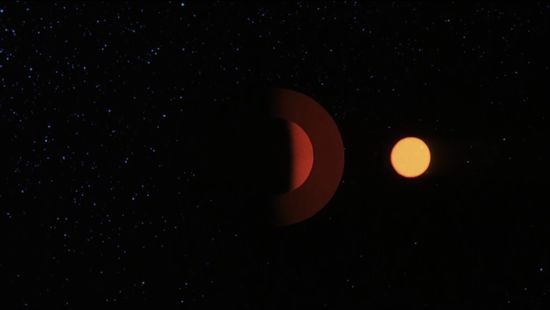
Unfortunately, it’s a bit downhill from there. The brilliant ants advance their plans to take over. Scientists try to stop them. It is all incredibly boring.
That said, there are some fantastic sequences wordlessly showing the ants in close-up figuring things out. These bits are punctuated by swooping, doom-drone synths and are gorgeous and fascinating to watch.
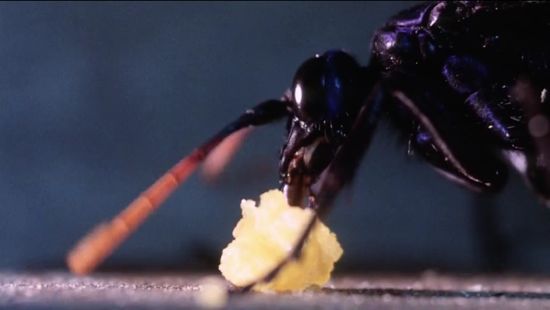
Also, the set pieces and art direction are straight-up beautiful and on point. He does the sort of minimalist, cold sci-fi set stuff that Kubrick did, and which went on to influence basically everything in the 70s.
I mean seriously, this stuff is gorgeous.
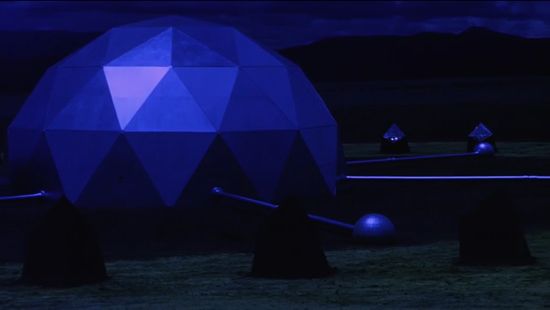
That said, all of the shots with people exchanging dialogue are stultifyingly dull. The plot advances, but it does so with no real sense of urgency or peril. In that, it approximates what I imagine it would be like if we were watching actual scientists doing actual science in the face of impending doom, but it certainly doesn’t make for good cinema.
Thankfully, there are all those gorgeous people-less art sets, and all those eerie, creepy close-ups of the insects fucking with their shit. This movie is worth watching for the flashes of visual beauty, but I can’t heartily recommend it overall, because it’s so uneven.
28. The Texas Chainsaw Massacre (1974)
So last month I had the good luck and enjoyment of attending MondoCon, a convention based around pop-culture ephemera, specifically screenprinted movie posters, limited-edition vinyl versions of horror movie soundtracks, and various and sundry other things. It was absolutely fantastic– I met so many incredible artists, many of whom I’d been a huge fan of for years. I also picked up a ridiculous amount of vinyl.
One of the truly awesome things MondoCon did was set up movie showings. I saw Ghost in the Shell on the big screen, and picked up a gorgeous poster for it. They also showed The Texas Chainsaw Massacre with a live score performed in the theater by the musicians, Anton Maoif and Umberto, who played as “The Hook and Pull Gang.”
Now, I love TCM. A lot. I’ve seen it many many times, and for my money, it’s one of the best horror movies of all time. It’s not without its problems, but by and large it does an incredible job juggling tone, and provides a sense of eerie dread and discomfort the whole way through. With the new score, it was absolutely incredible– just these deep synth tones, low notes hammering endlessly and never letting up. It raised my arm hairs for nearly the whole time and I forgot I was in the theater for a little while. It was incredible. After the show, attendees were given copies of the score on vinyl, I got those fellows to sign it, and it holds a place of honor in my collection.
Last weekend I was out of town, and in the hotel, we happened upon TCM being shown on television. I had no choice but to watch it.
The new score is amazing and outstanding, but even without it, this movie was incredible to watch. Just as fresh and terrifying as when I first watched it in Junior High with my friends, clutching the sides of the armchair and gritting my teeth.
Anyway. Yeah. So good.
This came as a recommendation from a dude who was making fun of my earlier choices. Man, that dude is a fool about my choices thus far (except Grave Encounters. Man, what a horrible piece of shit). Therefore, I really wanted to watch this movie and have it be terrible so that I could then shove that back in his face.
But this movie was great. I’ve always been a fan of New Zealand comedic horror flicks– Dead Alive, Black Sheep, um, other early Peter Jackson movies— and this flick stays right in that wheelhouse. It is hilarious. It is also creepy as shit.
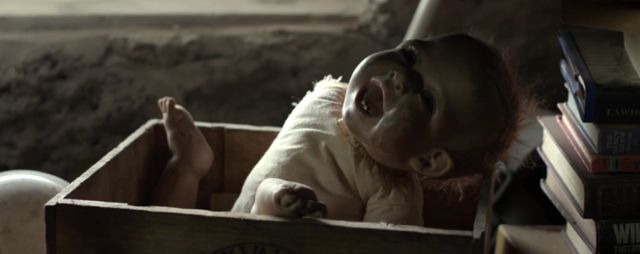
There are even some moments where it is both at the same time.
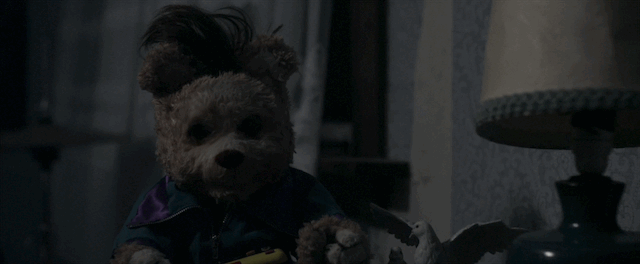
Oh yeah. Mike said I needed to learn how to make animated gifs. So I’m trying that now.
Anyway, the plot is thus: a young lady, who is also a meth addict, gets busted robbing an ATM and is sentenced to house arrest. Eight months trapped in her house with her doting mother, her stepfather, and what may or may not be a ghost, or maybe a serial killer, or maybe just a straight-up insane person, or maybe it’s all in her head. There are a few twists and turns, which actually work really well throughout.
What really sells it, though, is the acting. The lead, Morgana O’Reilly, really plays this part to the hilt. She plays the furious meth-addict recovering (and just seething with rage) in her mother’s house, being unable to go anywhere, and feeling persecuted and victimized. She does this with subtlety, grace, and fucking impeccable comic timing.
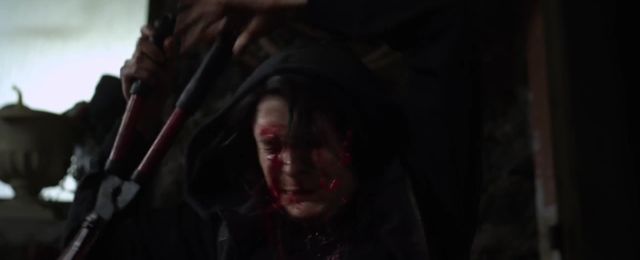
Rima Te Wiata plays her mother, and is pitch-perfect as the weird, well-meaning but slightly out-of-touch (and a little racist) mother, a perfect foil for O’Reilly’s eye-rolling and silent lip-whitening. The supporting cast is made up of various misfits, weirdos, well-meaning but silly psychiatrists, and doubting cops, all shining through in their character-actor glory.
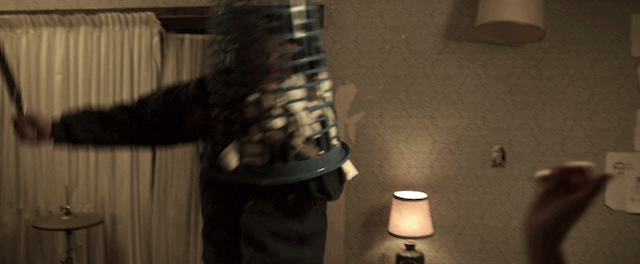
Eight out of eight kiwis. Belongs on any shelf next to Dead Alive and Black Sheep.
Today I’ll be devoting myself to two movies and two movies only. The Abominable Dr. Phibes and Dr. Phibes Rises Again!, two delightful camp-horror films from the early 1970s starring Vincent Price.
These movies are 100% awesome.
25. The Abominable Dr. Phibes (1971)
This movie is a goddamn masterpiece. A beautiful, British, early-70s, art-deco, camp masterpiece.
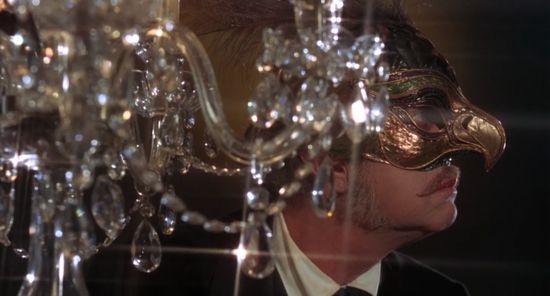
Here’s the setup. Vincent Price plays Dr. Anton Phibes, a brilliant doctor and professional concert organist. While abroad, his wife took ill and required emergency surgery. While speeding to her side, his car went over a cliff and caught fire. His wife died on the operating table, under the scalpel of a doctor played fantastically by Joseph Cotten.
Everyone thinks Dr. Phibes is dead, but that’s not true. He was just horribly disfigured. And now he’s back for revenge, planning to kill Dr. Vesalius (played by Cotten) and the eight other doctors who had a hand in what he views as his wife’s murder. His methods, of course, will all incorporate the ten plagues of Egypt, from the Bible.
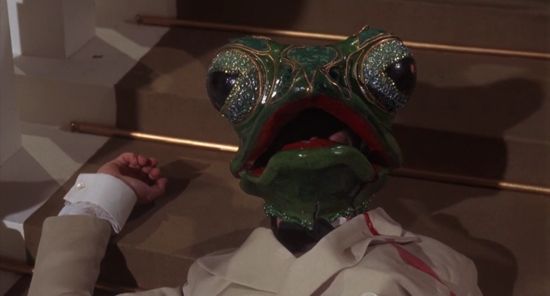
So this guy, for example, is slowly strangled by a frog mask, until he barfs blood and falls down some stairs.
Everything’s coming up roses for Dr. Phibes.
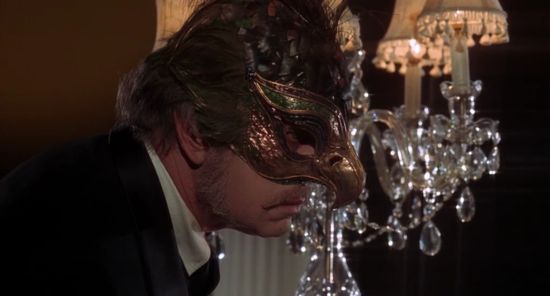
He slowly works his way through the other doctors. I can’t show you all of them, although I want to. He kills one with bees, one with blood, one with beasts.
He kills a pilot by releasing a shitload of hungry rats into the cockpit, while the guy is in midair:
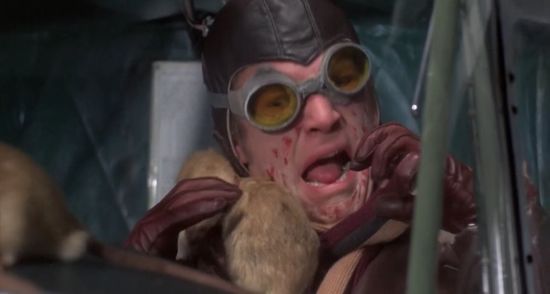
When the plane crashes into a horrible fireball, he twirls his telescope and applauds, while his beautiful assistant Vulnavia plays the violin.
You know, just like you or I would do.
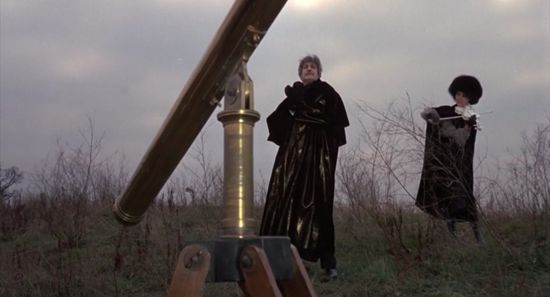
The sets, wardrobe, and composition of this movie are incredible. The production went balls-out on the art-deco. It’s set in the late 1920s, and they spared no expense to make it look as grandiose and ornate as possible.
And Vincent Price is INCREDIBLE in this movie. Dr. Phibes’ actual face is super-messed-up, and the “Vincent Price” face is just bits of latex prosthesis spirit gummed onto his charred skull, basically. He can’t use his mouth to speak– or do anything else. So there are hilarious shots of him eating and drinking by putting the spoon or glass around to the back of his neck.
And because he can’t speak normally, he’s lucky he was a genius at electronic music. He rigs up a methodology by which he can plug a quarter-inch phono jack into his neck and speak through an old-school Victrola horn. While his dialogue plays onscreen, Price does his absolute best to mimic speaking the dialogue while keeping his mouth closed, which is hilarious and creepy at the same time.
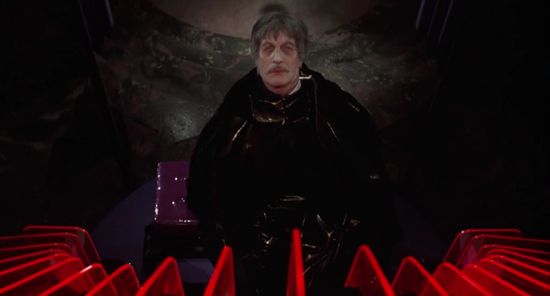
The murder methods are Rube Goldberg affairs in some cases, gruesome little mini-adventures, and the promise of their impending display kept me on the edge of my seat, while the sets and framing of the shots kept me dazzled.
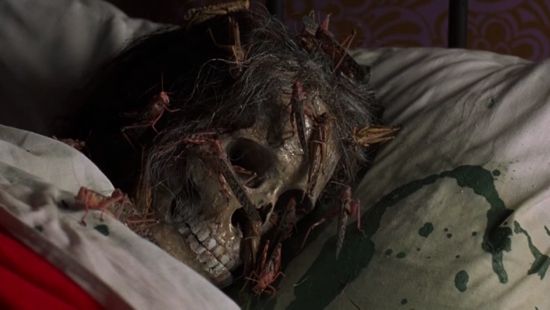
I hadn’t planned on watching the sequel, but I loved the first one so much…
26. Dr. Phibes Rises Again (1972)
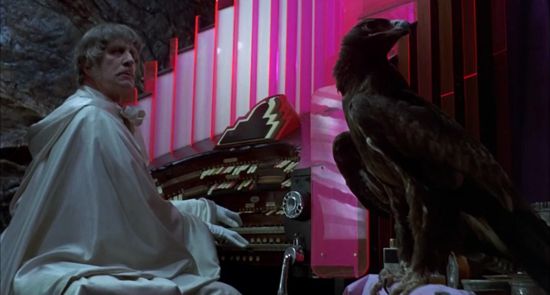
This one doesn’t make quite as much sense. In the first movie, Dr. Phibes is out for revenge. In this one, there’s some cockeyed scheme about a magical river in Egypt that can bring his wife back to life, and grant him immortality. Instead of a doctor struggling for survival against Phibes, there’s a centuries-old man desperate to retain his youth and bring his wife along so she can also live forever. Phibes’ foe has a number of hired hands and lackeys that Phibes is given the opportunity to kill, but it seems much more like he’s doing it for the sheer joy of murder than out of the righteous fury he displayed in the first movie.
Which is fine, because the murders are still hilarious and awesome.
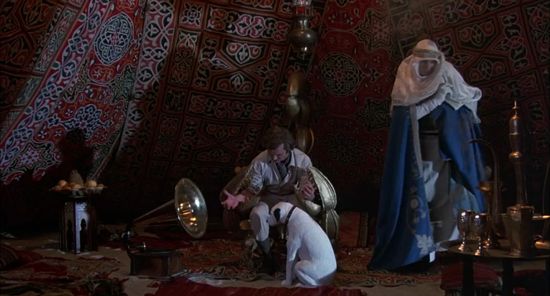
Also, the first one was apparently enough of a hit to justify boosting the budget for this one. What it lacks in intelligent plot and character motivations, it more than makes up for in design, ostentatious costumery, and over-the-top sets.
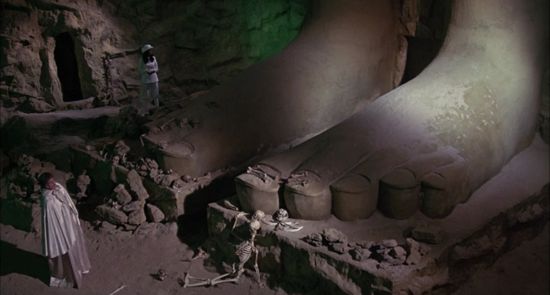
These movies are so much fun.
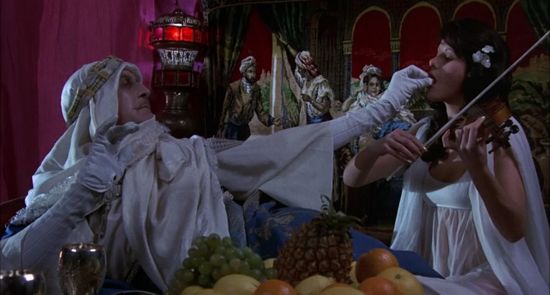
I don’t really have much else to say.
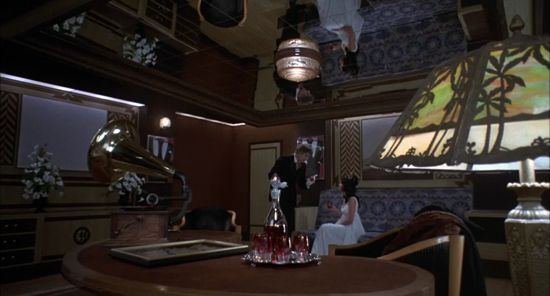
This is just an excuse for me to post more awesome screenshots.
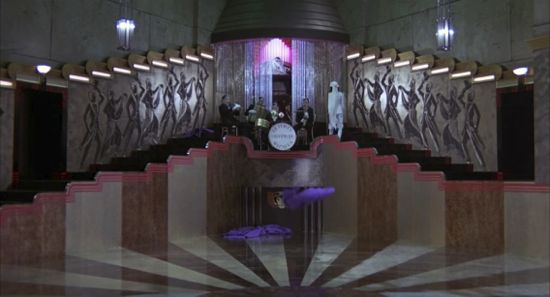
You should check these movies out.
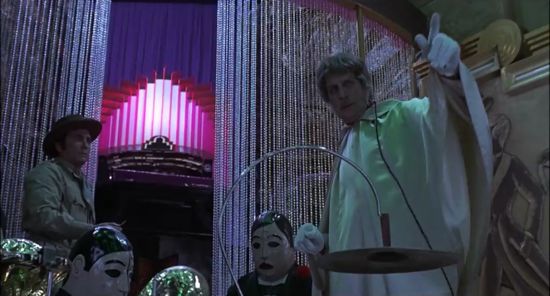
Howdy. Here are more of the 31+ horror movies I’m watching this October.
After Visiting Hours, I needed to cleanse my palate with something inoffensive, goofy, and ridiculous. Witchboard seemed to fit the bill perfectly. Silly 80s “evil ouija board” movie, starring Tawny Kitaen (of Whitesnake video fame).
It was everything I hoped. Some great laughs, some fantastic character actors, and solid performances from the three leads.
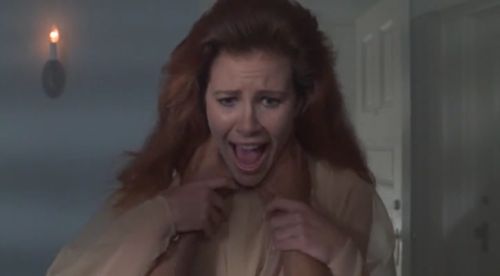
Exactly as expected. “Oui” out of “ja.”
22. Tales From the Crypt (1972)
I have a soft spot for the Amicus anthology horror films of the 60s and 70s, but I’d never seen this one before. I’d seen Vault of Horror, Asylum, and From Beyond the Grave. These things are usually a lot of fun– they get high-profile actors, are filmed in a very pretty way, and usually come from great source material– Robert Bloch, EC Comics, that kind of thing.
This one draws inspiration directly from EC comics stories– hence the title. And there are some dazzlers.
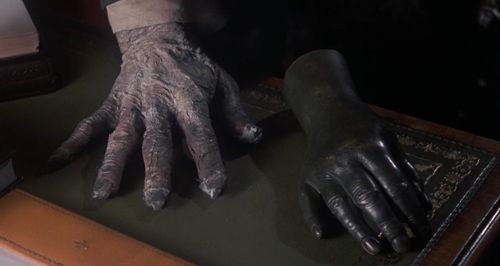
This one has pretty big roles for Joan Collins, Ralph Richardson, and Peter Cushing, among many others, and they turn in good performances. About half the horror is fairly bloodless, but it still works, by providing a nice, creepy atmosphere. The special effects vary from story to story, but even when they’re bad, they’re good.
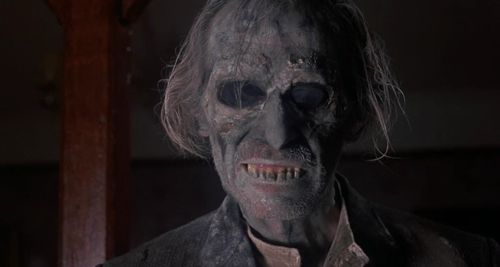
These stories seem to serve the same purpose as the EC comics they’re based on. They’re wry, tongue-in-cheek, and manage to be genuinely creepy on occasion.
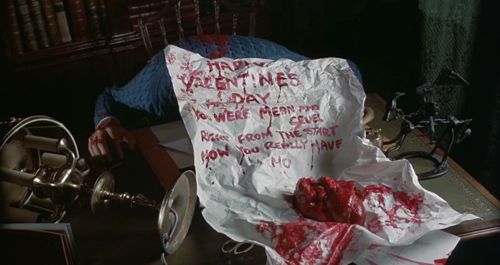
If you know Amicus Horror, you should know this already. If you don’t, this is a pretty good introduction.
What’s this? Oh, it’s another “found footage” film about a reality TV show about ghost hunting set in an abandoned mental hospital? No thanks, I’ve seen that several times before. What’s that you say? Oh, a 6.1 on IMDB? Better than 50% on Rotten Tomatoes? Weird internet cult that loves it? Okay, if you say so.
Ugh.
This movie is a horrible piece of shit.
Just like every other “found footage” movie set in an abandoned hospital / mental institution / et cetera.
The thing that never ceases to amaze me about these things is that, every single time, it looks like the people making these movies have never actually watched a shitty reality ghost hunting TV show. They always film everything– even the framing segments, where the “host” sets up the concept– with super-terrible shakycam. Guys, reality TV shows use tripods for those shots. Also, mostly, reality TV shows use steadicams. Or at least a cinderblock attached to a pole. Just because it worked for Blair Witch Project— a movie which in no way claimed to be done by professionals– does not mean it will work for you, or the two dozen other found footage / abandoned hospital movies.
I couldn’t even muster up the give-a-fuck to take a screenshot. Blegh.
Also, Barb pointed out that the guys who directed this movie are called “The Vicious Brothers.” Despite being neither brothers, nor vicious, nor related in any way. “The Vicious Brothers.” That is what dudes in rural towns who upload “Jackass” style videos in 2014 call themselves; or fellows who record Insane Clown Posse concert videos from the back third of the venue with their iPhones and upload them, in the mistaken, delusional belief that it will lead to them somehow becoming the band’s official videographer. Stop.
This movie is just corny as all hell. It’s about a tourist trap in rural somewhere, featuring telekinetically controlled murder mannequins and a Leatherface stand-in. It’s a little uneven, but there are a lot of things that really work about it. The scene opens on some teenagers whose car has already broken down, forcing one of their number to find a gas station or auto shop.
One of them finds one… and… his… doom.
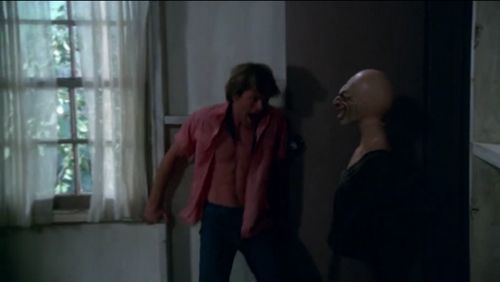
One of the highlights of this movie is the set dressing and special effects– the art direction was done by Robert A. Burns, the same dude who worked on Texas Chainsaw Massacre, which goes a long way toward explaining that. The teenagers are beautiful, of course, and the “last girl” is a very capable and effective actor.
The sets and mannequins are effectively creepy.
The actual evil antagonist, who apparently was called “Plasterface” on set but not in the movie itself, is interesting– the masks are a little creepy, the outfits are interesting, the methods of murder are pretty damn good– but oh my god, the voicework is terrible. The guy is two octaves short of sounding like a radical laryngectomy patient with a buzzbox.
And he keeps screaming things like “COME BACK, LITTLE GIRL!”
I sent Ed Ringtone an audio SMS and he laughed for a long time.
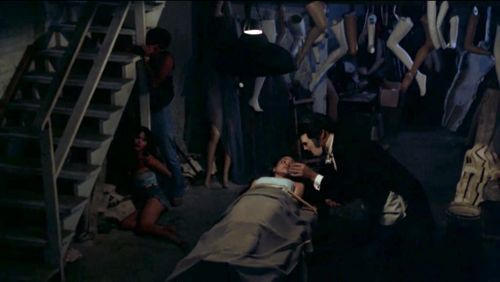
The score is also pretty hit-or-miss. There are times when the music works with the visuals and literally gave me goosebumps, but there are just as many times when I found myself rolling my eyes at the corniness of the whole thing.
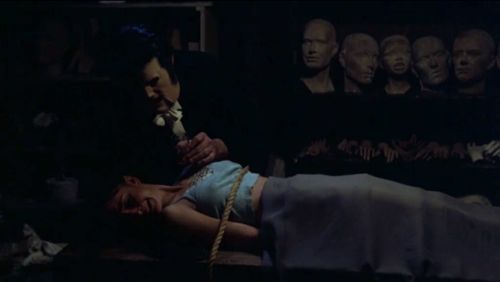
A solid effort, far from the worst movie I watched during the course of this October. One thumb up.
Hello.
Welcome once again to a discussion of horror movies that I’ve seen this month, in an effort to watch 31 new-to-me horror movies in 31 days. Today, I’ll be talking about three of them.
Here we go.
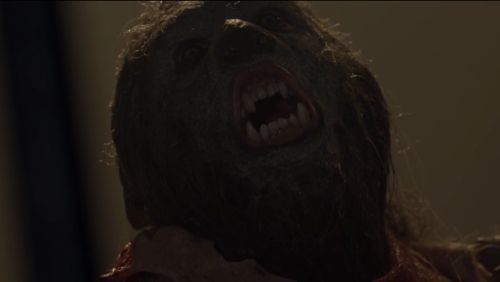
Honest to god, the lead guy’s name is “Lou Garou.”
This movie had me right where it wanted me within five minutes. In the following screenshot, the coroner investigating a heroin overdose death has just set his cruller down on the knee of the deceased in order to put on his latex gloves. It was a throwaway moment. Wasn’t on screen for more than a second or two. And I couldn’t stop laughing. You got me, WolfCop.
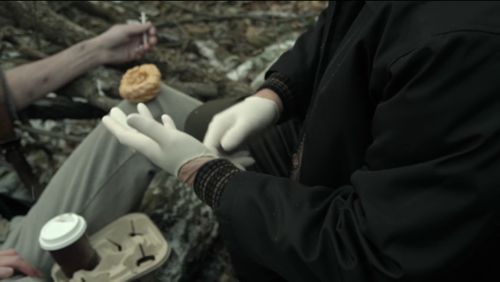
There are a number of screenshots I won’t post here of the actual transformation that “Lou Garou” undergoes to become a werewolf. The reason I will not post them here is because they show graphic blood graphically spurting out of his graphic penis. It’s hilarious, and made Ed Ringtone say “You had me at blood piss,” but I have to draw the line somewhere regarding what I’ll show on this blog. And as evidenced by yesterday’s post, that line is “Somewhere a little short of where BBC TV will.”
I’ll still show you some of the hilarious gore, don’t you worry.
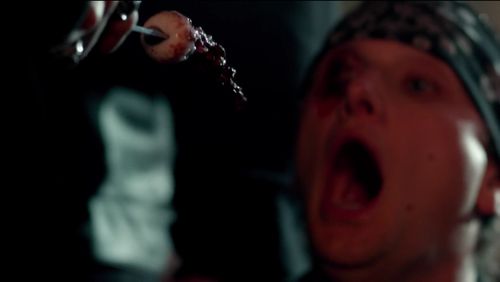
The basic premise of the movie is that a small-town, asshole, lazy, alcoholic cop becomes a werewolf at the hands of “shapechangers.” The shapechangers do this so that they can then trap the werewolf during the eclipse, when he is vulnerable to harm, and then drain his blood. Drinking (or snorting) werewolf blood allows the shapeshifters to retain their powers, and stay alive for centuries, as long as they have a supply. The actual procedure for lycanthropization is a little out of the known canon, but whatever. Asshole drunkard cop becomes a werewolf.
What more do you need, really?
The following screenshot comes from a scene wherein WolfCop stops a small-town convenience store robbery being perpetrated by three idiots in pig masks. Yes. Three little pigs. One of them screams “What are you?”
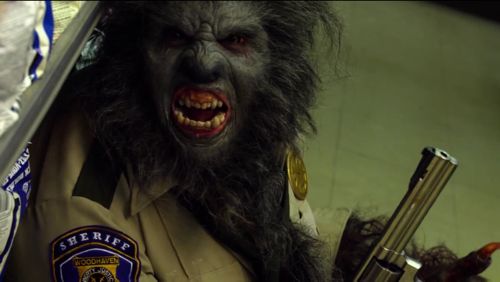
He growls back, “The Fuzz.”
Then there is a five-minute montage where the WolfCop takes his car into a closed Auto Body Shop and makes sparks fly everywhere. He’s wearing goggles, he’s got the pneumatic drill, the whole thing.
He’s converting his sheriff’s car into the WolfCopMobile, you see.
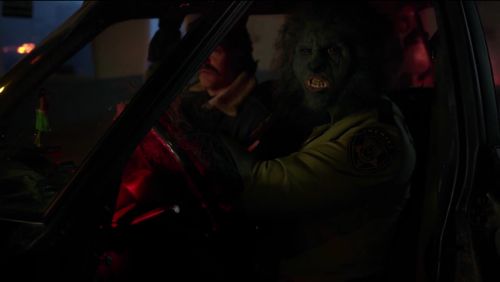
The goddamn WolfCopMobile.
Then he goes driving around the rural roads looking for crimes to stop. One conceit of the movie is that during the full moon, the WolfCop straight-up cannot be harmed. So there are lots of fun shots of him just getting riddled with bullets and not giving a single shit.
Anyway, at one point, WolfCop crams his head out the window and starts sniffing. He can smell trouble. He can smell a meth lab, miles away. What’s a WolfCop to do, but go and bust it up?
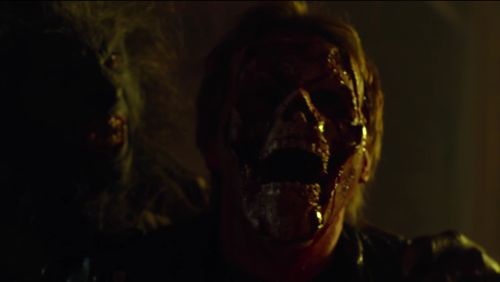
I don’t want to give too much away, but there is, of course, a love scene, between WolfCop and a woman dressed like Little Red Riding hood. It comes out of nowhere, it takes place in a jail cell, and all of a sudden cheesy soft-rock starts playing and there are candles everywhere.
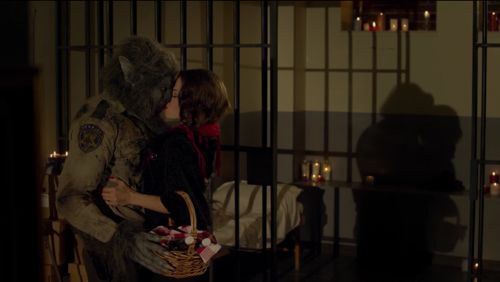
The only way it could have been any better is if they’d actually gotten the rights to “Take My Breath Away” and played that instead.
The problem with most movies that attempt to do the whole balls-to-the-wall, goofy 80s funny-action movie thing, is that they tend to fail miserably. They don’t understand what makes things cheesy-funny. They often accomplish the cheesy, but it’s not the right flavor of cheesy, or it’s cheesy but not funny, or they take lot of pauses to stare straight into the camera and grin and gawk, miming “look how funny we’re being.”
Usually, unless the movie was actually made in the 80s, and was actually made by someone trying in earnest to make a good movie, your average faux-corny shitty movie will fail. It will fail horribly, and it will make me hate you forever.
WolfCop is that rare beast, a movie that somehow gets it right.
I went into this with low expectations. I saw this movie pretty much solely because I already bought the soundtrack on vinyl. I only bought the soundtrack on vinyl because a guy a sort of know, Randy Ortiz, did the art for it. Randy is fantastic. And the art is fantastic. And the gatefold of the vinyl is basically what convinced me to give the movie an honest shot. Here is that gatefold:
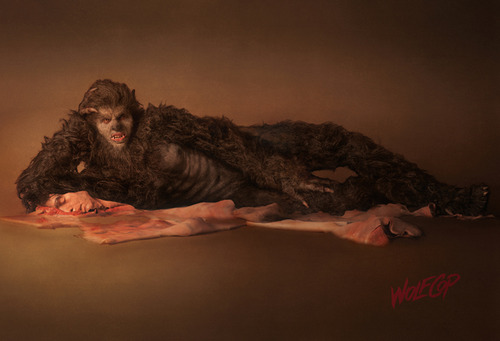
I can’t recommend this movie highly enough. It is so ridiculous, so low-budget and high-laughter.
Road Games was another pleasant surprise. I only watched it for two reasons: Stacy Keach and Jamie Lee Curtis.

Stacy Keach plays a long-haul trucker in Australia. He’s been working four days straight with very little sleep, and he’s called upon to do another job–hauling a truckload of meat to Perth. He’s a little on edge, pretty tired, and also convinced that he’s being followed by a knife-wielding maniac who’s already killed a bunch of girls on a rampage.
Jamie Lee Curtis is a hitchhiker he picks up along the way, and who becomes involved in the investigation.
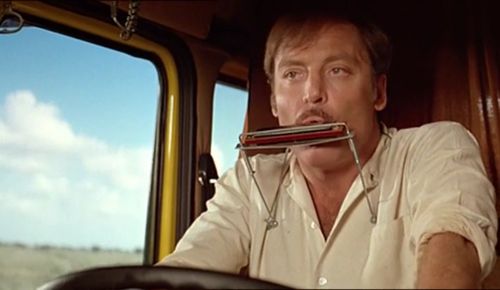
This is basically a road movie– 80% of the film takes place inside the cab of the big rig– and as such, I expected to be bored. I was surprised that I was engrossed throughout. Mostly due to Stacy Keach’s incredible acting abilities, especially when paired with the various misfits he interacts with along the way. The driver maintains a running commentary about the people in the other cars, and it’s often funny.
Additionally, the pacing and camera work is top-notch. It simmers for long periods of time before breaking into a boil, and the third star of the movie is honestly the Australian scenery.
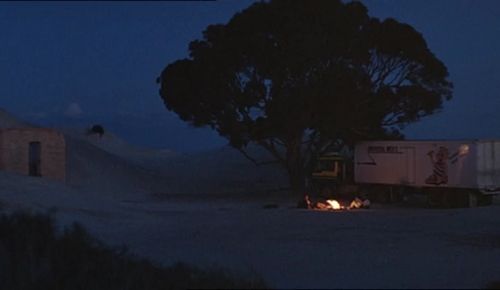
Slow, pretty, well acted and directed. Two thumbs up.
Michael Ironside, William Shatner, Lee Grant, and Linda Purl. What could go wrong?
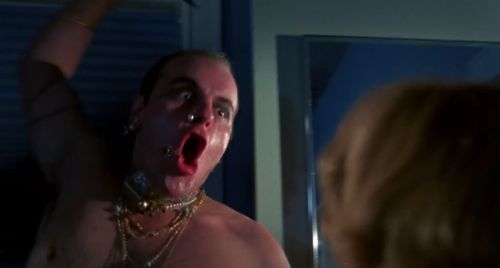
Goddamn everything.
Needlessly cruel, stultifyingly slow. The Shat and ol’ Ironside do their best, and turn in pretty good performances, but they can’t save what is essentially a brainless, crappy, poorly-done slasher flick.
Join me next time for a discussion of four more movies, one of which is godawful, one of which was pretty good, and two of which are cheesy and awesome.
Welcome back to another edition of “some horror movies I’ve watched this month.” I’m Keef, and I’m watching (at least) 31 horror movies during the month of October, as previously discussed. Instead of the batch-movie format, this post will discuss a single movie, mostly because I started writing about it and then couldn’t stop.
17. Schalcken the Painter (1979)
This was a really pleasant surprise. Schalcken the Painter is a BBC movie based on a short story by Sheridan Le Fanu, starring Jeremy Clyde in the title role, with a fantastic supporting cast. But really, the star is the filmmaking and set design itself. In the creation of this movie, the lighting, camerawork, and eerie stillness takes center stage. There are many shots of the painters at work, showing the models in their poses and surroundings, clearly meant to evoke or even reproduce the works of the old Dutch masters themselves. It’s nearly Barry Lyndon-esque in its beautiful lighting and careful pacing.
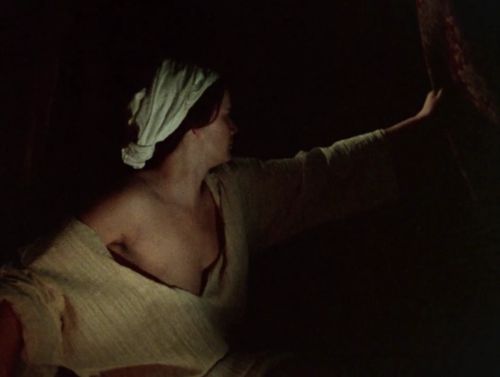
Additionally, the whole thing is narrated, and there are many pauses for what is in effect a brief historical lecture on Dutch art in the 15th century, providing some context for the action. Very informative, about the historical figures involved and the larger societal mores and attitudes, which inform the plot a fair amount. To its credit, this information is delivered very well, being interesting and informative without becoming preachy or boring.
It doesn’t hurt that there’s a lot of nudity in this movie.
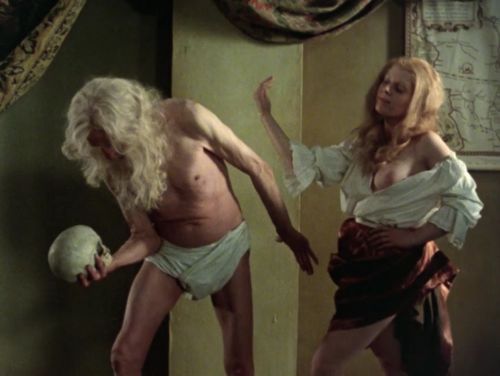
After the first ten movies or so in this series, when I had the idea to start blogging this stuff, I started taking lots of screenshots of these movies as I watched them. I knew that it would be fun to show these afterwards, and taking them in the moment meant that I had the ability to sort of “live tweet” these things via text with some friends. Take a screenshot, send it to a friend with commentary, chat about the movie. So I chose a lot of funny or interesting screenshots– I went for frames with good composition, or startling horror or gore aspects, or nudity.
Did I mention that this movie– a BBC TV movie– has a lot of nudity?
And so but anyway, I’m sending text messages back and forth with Ed Ringtone, and he made a remark that this looked like “Whoops My Titty: The Movie.”
Which is not entirely inaccurate. In an effort to recreate the paintings of the Old Masters, many of which included nudity, the movie itself incorporates those same titty-related elements.
Unfortunately, the adherence to the source material provided another side effect– the movie itself was shelved for being prurient, and was unavailable for a very long time. It is now available for purchase on the BFI website, but if you read the IMDB reviews page, as I did because this movie is incredibly good, it’s riddled with people complaining about the lack of availability of this film. They discuss how it was shown about three times in the last thirty-five years, including the initial airing, and half of the reviews include pleas for anyone who owns the movie to contact the reviewer to trade VHS tapes or whatever.
The fact that so many people, a quarter-century after the fact, remembered this film fondly and desired a repeat viewing, says more about the haunting and memorable qualities of the movie than I could.
Now here’s some more nudity.
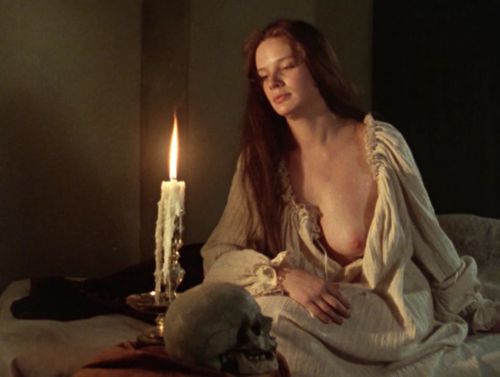
Also, my god, the costumes and wardrobe in this thing. In conjunction with the lighting and direction, this movie looks good enough to eat.
Anyway, the story starts with the title character being a lowly student, studying under the painter Gerard Douw, who was at the time much more well-known. Over the course of his studies, Schalcken falls in love with Douw’s niece, the beautiful Rose, played fantastically by Cheryl Kennedy. She, of course, also falls for him, in a beautiful playful back-and-forth of shared glances and affectionate grazes.
Alas, there is conflict. A strange man, claiming to be “Minheer Vanderhausen of Rotterdam,” shows up. He offers Douw, nearly blind in his old age, a fortune in gold for the hand of his niece. From the story, and neatly paraphrased in the film:
Gerard Douw knew nothing of the attachment which had sprung up between his pupil and his niece; and even if he had, it is doubtful whether he would have regarded its existence as any serious obstruction to the wishes of Minheer Vanderhausen. Marriages were then and there matters of traffic and calculation; and it would have appeared as absurd in the eyes of the guardian to make a mutual attachment an essential element in a contract of the sort, as it would have been to draw up his bonds and receipts in the language of romance.
Douw agrees, and in effect sells his niece to Vanderhausen.
Neither Schalcken nor Rose have any idea about any of this. The man shows up at dinner and throws back his hood, revealing that he is horribly, horribly wrong:
all the flesh of the face was coloured with the bluish leaden hue… the eyes showed an undue proportion of muddy white, and had a certain indefinable character of insanity; the hue of the lips bearing the usual relation to that of the face, was, consequently, nearly black; and the entire character of the face was sensual, malignant, and even satanic.
Rose says something to the effect that she would not like to ever see that man again, which is when Douw drops the bomb that she is now engaged to the walking corpse. Surprise!
Rose begs Schalcken to elope with her. He refuses, saying that he will become a rich painter, and then buy out the marriage licence (or whatever weird equivalent existed in 15th century Netherlands).
She packs her bags, gives him a last glance, and goes.
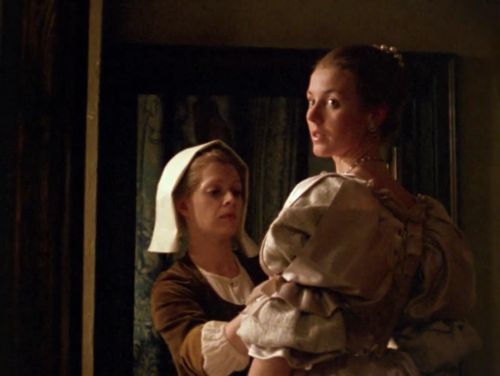
Despite the movie itself being more than a third of a century old, and itself based on a hundred-and-fifty year old short story that’s in the public domain as part of the Gutenberg Project, I still get squeamish and discomfited about posting any spoilers.
So. Spoilers ahead. Here there be spoilers.
A few weeks after the marriage, Douw hears nothing from Rose, and asks Schalcken to go find her. He goes to Rotterdam, and can find hide nor hair of Vanderhausen or Rose.
He gives up. He gets older. He remains unsatisfied, and begins to paint damning indictments of capitalism and the intermix of money and affection that existed at the time. After a long period of years, Rose returns to the house, all scratched up and rough. She begs Schalcken not to leave her alone. Frenetic, worried about her, he steps out of the room for a minute– and hears screaming. The door slams shut. He eventually gets it open, and discovers the window inside is open, and there are ripples in the water of the canal below.
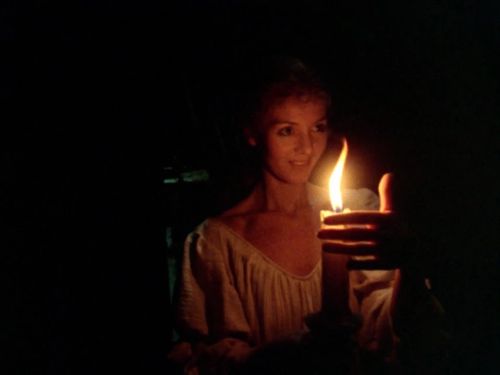
Then, things start to get really bad.
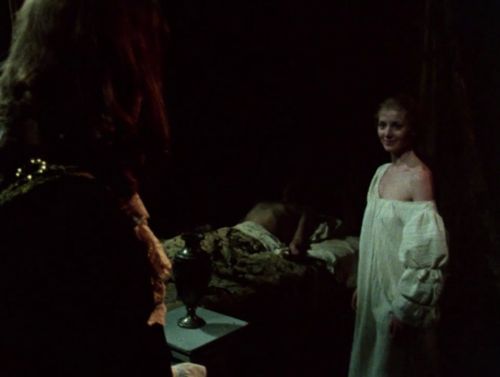
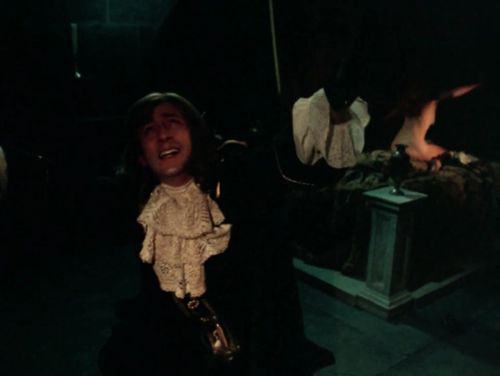
NO MORE TEXT SPOILERS WATCH THE DAMN MOVIE